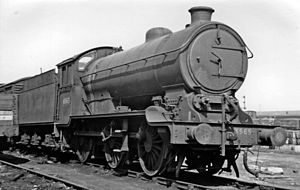LNER Class J39
This article includes a list of general references, but it lacks sufficient corresponding inline citations. (June 2014) |
| LNER Class J39 | |||||||||||||||||||||||||||||||||||||||||||
|---|---|---|---|---|---|---|---|---|---|---|---|---|---|---|---|---|---|---|---|---|---|---|---|---|---|---|---|---|---|---|---|---|---|---|---|---|---|---|---|---|---|---|---|
 No. 4965 at Grantham Shed 1947 | |||||||||||||||||||||||||||||||||||||||||||
| |||||||||||||||||||||||||||||||||||||||||||
| |||||||||||||||||||||||||||||||||||||||||||
| |||||||||||||||||||||||||||||||||||||||||||
| |||||||||||||||||||||||||||||||||||||||||||
The London and North Eastern Railway (LNER) Class J39 was a class of medium powered 0-6-0 steam locomotive designed for mixed-traffic work throughout the former LNER system between London and the north of Scotland.[3]
History
[edit]The class was introduced by Nigel Gresley in July 1926, based on his previous Class J38 (introduced in January 1926) but with larger driving wheels. The larger wheels enabled them to be used on both passenger and freight trains, although at the expense of a lower tractive effort. As a result they were given the BR power classification 4P/5F, rather than the 6F of the earlier class. A total of 289 examples were built over the next fifteen years, mostly built by the LNER's Darlington Works although 28 were built by Beyer, Peacock and Co. in 1935.
The larger wheels necessitated the provision of low splashers over the front two wheels, which is the main means of differentiating between the two classes. However the increased speed afforded by the larger wheels caused the big end bearings to overheat, something that was aggravated by their use on passenger trains, and reliability suffered as a result. The locomotives were all fitted with superheaters and Ross 'Pop' safety valves.[4][3]

All passed into British Railways ownership in 1948 and they were numbered 64700-64988. They began to be withdrawn from service in 1959 and all examples had been scrapped by the end of 1962.[5] No. 64747 served out the remainder of its days as a stationary boiler at the Woodford shed until October 1964.[6]
Sub-classes
[edit]
The class was divided into three sub-classes depending on the type of tender fitted.
- J39/1 Standard LNER 3500 gallon tender.
- J39/2 Standard LNER 4200 gallon tender.
- J39/3 Various former North Eastern Railway tenders 3940-4125 gallons.
Accidents and incidents
[edit]- Circa 1930, locomotive No. 1448 was derailed by trap points at Lumpsey Colliery, Brotton, Yorkshire.[7]
- On 28 August 1950, the connecting rod of a locomotive of this class became detached and consequently pierced the firebox, scalding the driver.[8]
- On 23 October 1950, locomotive No. 64880 was hauling a passenger train that was derailed at Drumburgh, Cumberland due to the condition of the track. Two people were killed and three were injured.[9]
In model form
[edit]Bachmann manufactures the J39/2 version in 00 gauge model form.[10]
Bassett-Lowke manufactures the J39/2 version in 0 gauge model form.
Union Mills manufactures the J39 in British N-Scale.
Graham Farish-Bachmann manufactures the J39 in N scale as BR black with late crest & stepped tender numbered as 64841 and 64880.
References
[edit]Citations
[edit]- ^ Boddy et al. 1982, p. 16.
- ^ a b c Boddy et al. 1982, p. 15.
- ^ a b Casserley 1960, p. 186.
- ^ Hughes 1992, pp. 50–53.
- ^ Stubbs & Boddy 1963, p. 9.
- ^ Marsden, Richard. "The Gresley J39 0-6-0 Locomotives". LNER Encyclopedia. Winwaed Software Technology LLC. Retrieved 8 October 2020.
- ^ Trevena 1981, p. 26.
- ^ "Locomotive failure near Winchfield 23 November 2013" (PDF). Rail Accident Investigation Branch. p. 32. Archived from the original (PDF) on 14 July 2014. Retrieved 17 June 2014.
- ^ Earnshaw 1993, p. 24.
- ^ "Branchline OO Scale Steam Locomotives". Bachmann Europe Plc. 13 December 2016. Archived from the original on 27 November 2010. Retrieved 25 October 2009.
References
[edit]- Boddy, M.G.; Neve, E.; Tee, D.F.; Yeadon, W.B. (September 1982). Fry, E.V. (ed.). Locomotives of the L.N.E.R., part 6A: Tender Engines - Classes J38 to K5. Kenilworth: RCTS. ISBN 0-901115-53-3.
- Casserley, H.C. (1960). The Observers book of railway locomotives of Britain. Federick Warne & Co. Ltd.
- Earnshaw, Alan (1993). Trains in Trouble: Vol. 8. Penryn: Atlantic Books. ISBN 0-906899-52-4.
- Hughes, Geoff (August 1992). "Talking to Thompson part II". Steam World. No. 62. Peterborough: EMAP Apex Publications.
- Ian Allan ABC of British Railways Locomotives (1962 ed.).
- Stubbs, W.T.; Boddy, M.G. (1963). Locomotive stock book 1963. Railway Correspondence and Travel Society.
- Trevena, Arthur (1981). Trains in Trouble: Vol. 2. Redruth: Atlantic Books. ISBN 0-906899-03-6.
External links
[edit]- The Gresley J39 0-6-0 Locomotives LNER encyclopedia
- Class J39/1 Details at Rail UK
- Class J39/2 Details at Rail UK
- Class J39/3 Details at Rail UK
